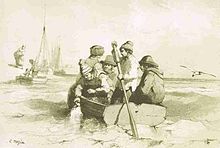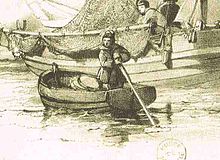Sculling

Sculling (also wricken , wriggln ) is the movement of a boat by means of only one rudder ( belt ) pointing backwards in the middle . This is moved back and forth sideways, with the reversal of movement in each case about 90 ° about its longitudinal axis.
In addition, the mere movement of the rudder blade back and forth (without turning) for propulsion purposes is called sculling.
Scaling in the strict sense (with rotation)


The oar is attached to the aft ( stern ) in a oarlock (scepter) or a rigging hole. With the right movement and posture, the belt blade describes the shape of a lying figure eight. During the figure eight movement, a feed across the "figure eight" is constantly achieved.
The sculling technique is similar to the locomotion technique of a Venetian gondola, with the difference that when sculling the oar is pointed astern, whereas the oar of the gondola is plunged sideways into the water and the one-sided propulsion is compensated for by the asymmetrical construction of the hull.
Sculling on sculling boats is the usual drive . But small sailing or motor boats can also be rigged, which makes sense, for example, when there is no wind or engine failure. With canoes , sculling with the paddle is used to support and move the boat sideways.
A Wriggregatta has been organized on the Breton coast between the island of Molène and Lampaul-Plouarzel since 2000. The fastest teams, whose members then take turns sculling about every three minutes, cover the approximately 8 nautical miles long distance in two and a half hours, which corresponds to a speed of over 3 knots .
Sculling by moving back and forth
Also called sculling is the simple movement of the rudder blade back and forth (without turning) for the purpose of propulsion on small sailing boats. Since the rudder blade is attached to the rudder shaft, it cannot be used to describe a “figure eight”, but only a pitch circle similar to the movement of a windshield wiper. The propulsion generated by the powerful movement is generally weaker than the corresponding propulsion by sculling in the narrower sense; In practice, it is often supported by rhythmic rocking of the boat hull around the longitudinal axis (see rollers ).
Web links
Individual evidence
- ↑ Daniel Kurzweil: Molène Lampaul / Plouarzel à la godille (accessed March 27, 2013)
- ↑ Text: Molène Lampaul 2010 le 25 juillet (accessed March 27, 2013)

